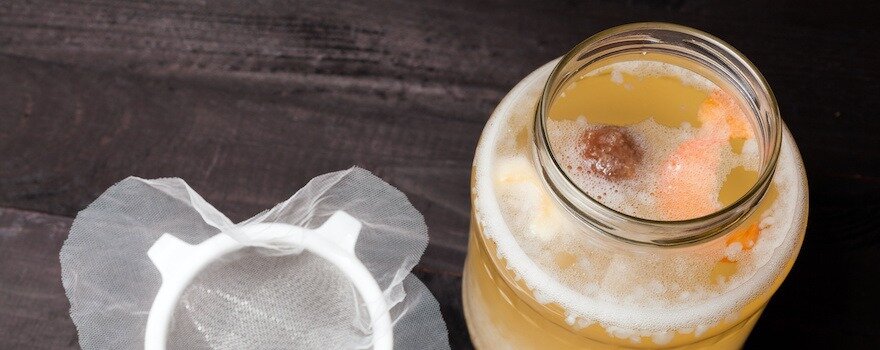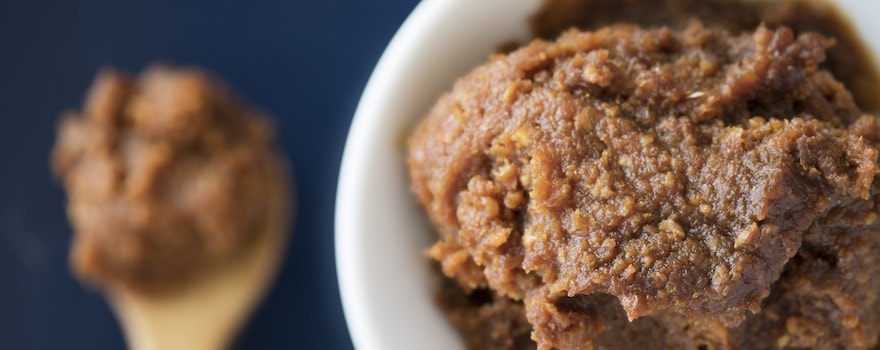Fermentation is a process during which microorganisms such as bacteria or yeasts convert the carbohydrates present in foods into acids, gases, or alcohol. Wine, for example, results from a fermentation of the sugar in grape juice by yeasts.
During lacto-fermentation (lactic fermentation), the carbohydrates present in foods are transformed into lactic acid by the lactic bacteria they contain. If you’re lactose intolerant, don’t avoid all lacto-fermented products! The term “lactic” simply refers to the fact that lactic acid was first isolated from milk.
Also read (PODCAST #1): The secrets of fermentation
Here are 4 lacto-fermented foods to include on our plates. See after the list for more details on lacto-fermentation and its benefits.
1. Sauerkraut

Sauerkraut is one of the most widely consumed lacto-fermented foods! It is made from cabbage to which a brine (a mixture of water and salt) is added. Rich in probiotics and in vitamin C, it contributes to the proper functioning of the immune system. It is said to have helped Captain Cook’s crews fend off scurvy.
How to eat it: you can find sauerkraut raw or cooked. To make your own sauerkraut, cabbage is fermented with brine in a sauerkraut crock. It can be paired with fish (haddock, salmon) and shellfish to make a seafood sauerkraut or enjoyed in a salad.
2. Kefir

Kefir is a beverage originating from the Caucasus. We distinguish milk kefir, produced from animal milk to which yeasts and cultures are added, and fruit kefir, made from fruit, water, sugar and water kefir grains. Rich in lactic bacteria, kefir has a probiotic effect as shown by this study.
How to consume it: milk kefir can be found in many stores. To soften its slightly sour flavor you can add a natural syrup or honey. Kefir is also available in powder form or as kefir grains to make your own beverages.
3. Sourdough bread

Natural sourdough is obtained from the fermentation of cereals. Traditionally it is made from wheat or rye flour. After adding water and salt, fermentation begins. Fermentation may generate antioxidants and prebiotic compounds, as suggested by this study.
How to consume it : it is recommended to eat sourdough bread made from organic flours. The preparation begins with a “starter” made of water and flour. Then the starter is fed with a mixture of water and flour. The mixture will start to bubble and give off a slightly sour smell.
4. Miso

Miso is a staple ingredient of Japanese cuisine, made from a fermented soy paste. Soy miso is a complete source of plant-based proteins. Its fermentation is accompanied by an increase in probiotics. This promotes good digestive health.
How to consume it : its taste is described as umami (the fifth taste). It can be found in Japanese grocery stores and organic stores. It can be used to season meats, in soups, broths, or stir-fry dishes.
Lacto-fermentation, bacteria that transform sugars
What is lacto-fermentation?
Among the foods suitable for lacto-fermentation are the most vegetables, such as the famous sauerkraut! Fruits are used less often. Indeed, one must be able to appreciate their taste after lacto-fermentation, which is slightly vinegary and salty. Fermented dairy products like kefir are another example of lacto-fermented products. Grains can also undergo this kind of transformation (sourdough for bread).
The fish is also a good candidate. This is the case, for example, with nuoc mam sauce, widely used in Asian cuisine. It comes from the fermentation of fish in a brine (a mixture of water and salt).
During lacto-fermentation, the lactic bacteria naturally present on the surface of foods will nibble at the sugars and convert them into lactic acid. This reaction leads to an increase in the lactic bacteria population and to a rise in the acidity of the environment. This process takes place in an oxygen-free environment.
What are the main benefits of lacto-fermentation?
Lacto-fermentation is an astonishing reaction! Indeed, it increases the amount of certain nutrients in foods. This study on the nutritional quality of fermented bitter melon and fenugreek leaves highlighted an increase in vitamin C and vitamin B12 compared to raw vegetables.
Also read the Where to buy probiotics?
During lacto-fermentation, populations of lactic bacteria will increase in foods. This will create a reservoir of probiotics (good bacteria) beneficial for our microbiome. These bacteria offer many benefits such as strengthening the immune system or an anti-inflammatory role.
Also read the 12 prebiotic foods: the best fibers to boost the health of our microbiome
Lacto-fermentation makes foods more digestible. For example, it reduces the amount of lactose in milk kefir. Additionally, the fibers of lacto-fermented vegetables are somewhat pre-digested by lactic bacteria, making them more easily assimilated by the body. By lacto-fermenting vegetables rich in prebiotics, you provide the body with fiber that serves as fuel for our beneficial gut bacteria.
Lacto-fermentation, what precautions?
Lacto-fermentation requires certain precautions. You should, in particular, carefully wash your hands, use airtight containers, and respect fermentation times. Experts can guide you in making your recipes.



